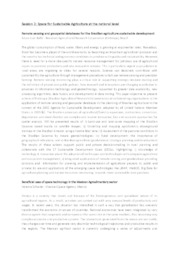Remote sensing and geospatial databases for the Brazilian agriculture sustainable development.
Remote sensing and geospatial databases for the Brazilian agriculture sustainable development.
Author(s): BOLFE, E. L.
Summary: The global consumption of food, water, fibers and energy is growing at exponential rates. Nowadays, Brazil has become a player of the world economy by becoming an important agricultural producer and the country has technical and agronomic conditions to produce with quality and sustainability. However, there is need for a more site-specific natural resource management for judicious use of agricultural inputs to promote productivity and also ecosystem services. This is particularly urgent as population in rural areas are migrating to cities for several reasons. Science can decisively contribute with sustainability the agriculture through management procedures which use remote sensing and precision farming. Remote sensing monitoring plays a critical role in supporting strategic decision-making and the definition of private and public policies. New research and innovations are changing rapidly due to advances in information technology and geotechnology, supported by greater data availability, new processing algorithms, data fusion, and developments in data mining. This paper objective to present actions of Embrapa (Brazilian Agricultural Research Corporation) and collaborating organizations in the application of remote sensing and geospatial databases in the planning of Brazilian agriculture in the context of the 2030 Agenda for Sustainable Development, adopted by all United Nations Member States in 2015 [6]. The Brazilian processes of agricultural/forestry expansion, contraction, conversion, degradation and diversification are complex and require innovative, fast and accurate approaches for spatial analysis. Will be presented results of: i) Land-use and land-cover mapping of the Brazilian Savanna based mainly on satellite images; ii) Modelling and mapping agroforestry aboveground biomass in the Brazilian Amazon using airborne lidar data; iii) Assessment of the pastures conditions in the Brazilian Savanna by means geotechnologies; iv) Rural development: the importance of geographical indications; and v) Brazilian agricultural geodatabase: strategic planning and development. The results of these actions support public and private decision-making in rural planning and collaborate with the 17 Sustainable Development Goals (SDGs). Highlighting: i) knowledge of technology & innovation about the adoption of techniques and technologies with adequate agriculture and ecosystem management; ii) integrated applications of remote sensing and geodatabase providing solutions and information for planning and implementation of agricultural projects to public and private; iii) use and applications of the emerging space technologies like LiDAR, WebGIS, Big Data for agriculture planning and natural resources monitoring towards more sustainable rural practices.
Publication year: 2019
Types of publication: Abstract in annals or event proceedings
Observation
Some of Embrapa's publications are published as ePub files. To read them, use or download one of the following free software options to your computer or mobile device. Android: Google Play Books; IOS: iBooks; Windows and Linux: Calibre.
Access other publications
Access the Agricultural Research Database (BDPA) to consult Embrapa's full library collection and records.
Visit Embrapa Bookstore to purchase books and other publications sold by Embrapa.

